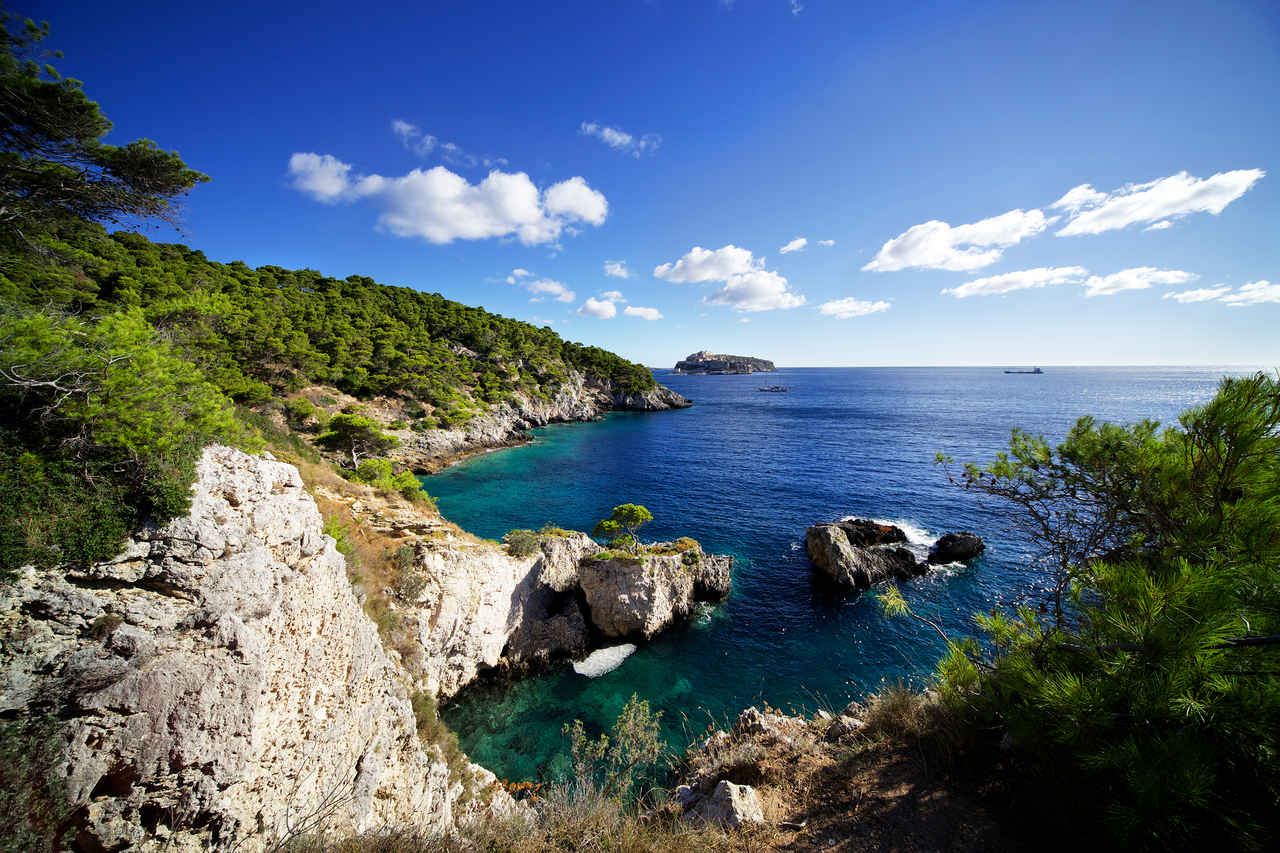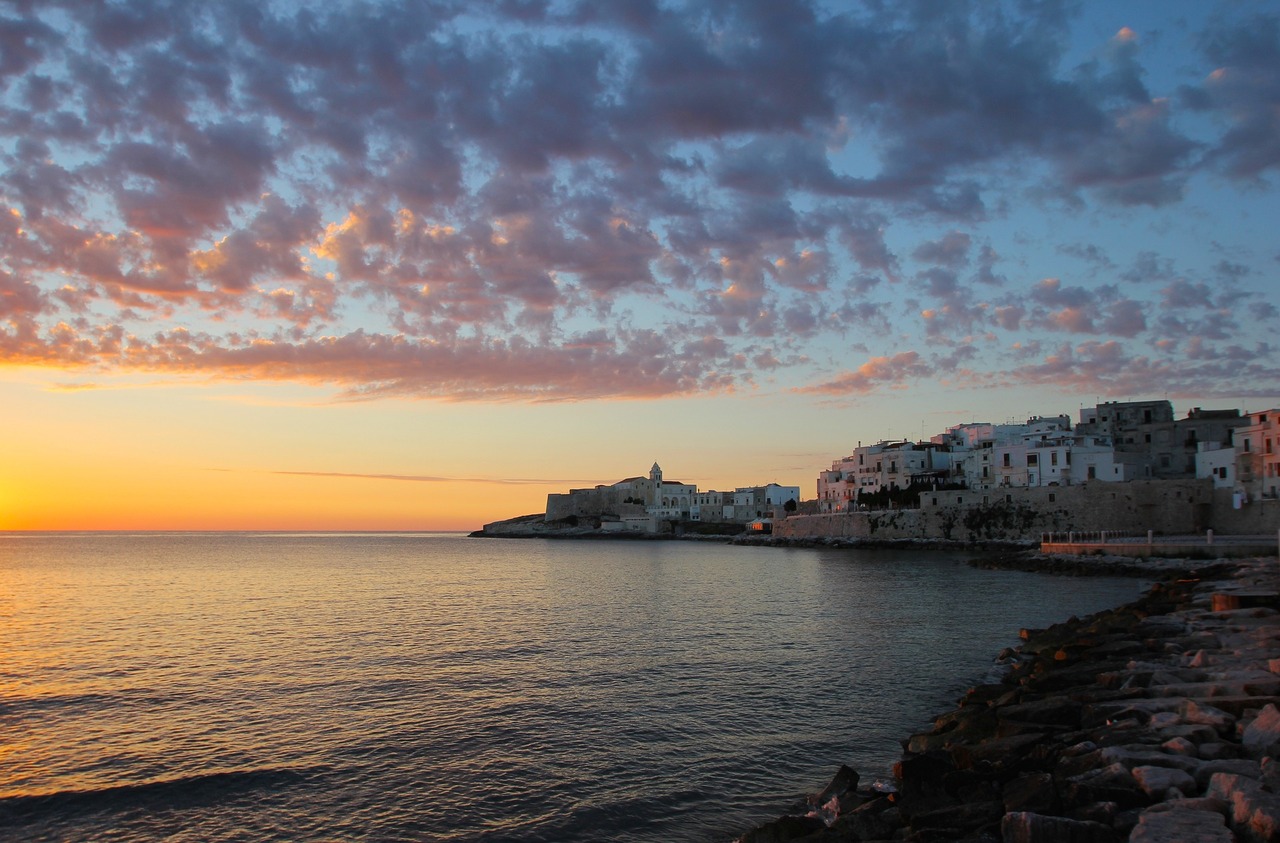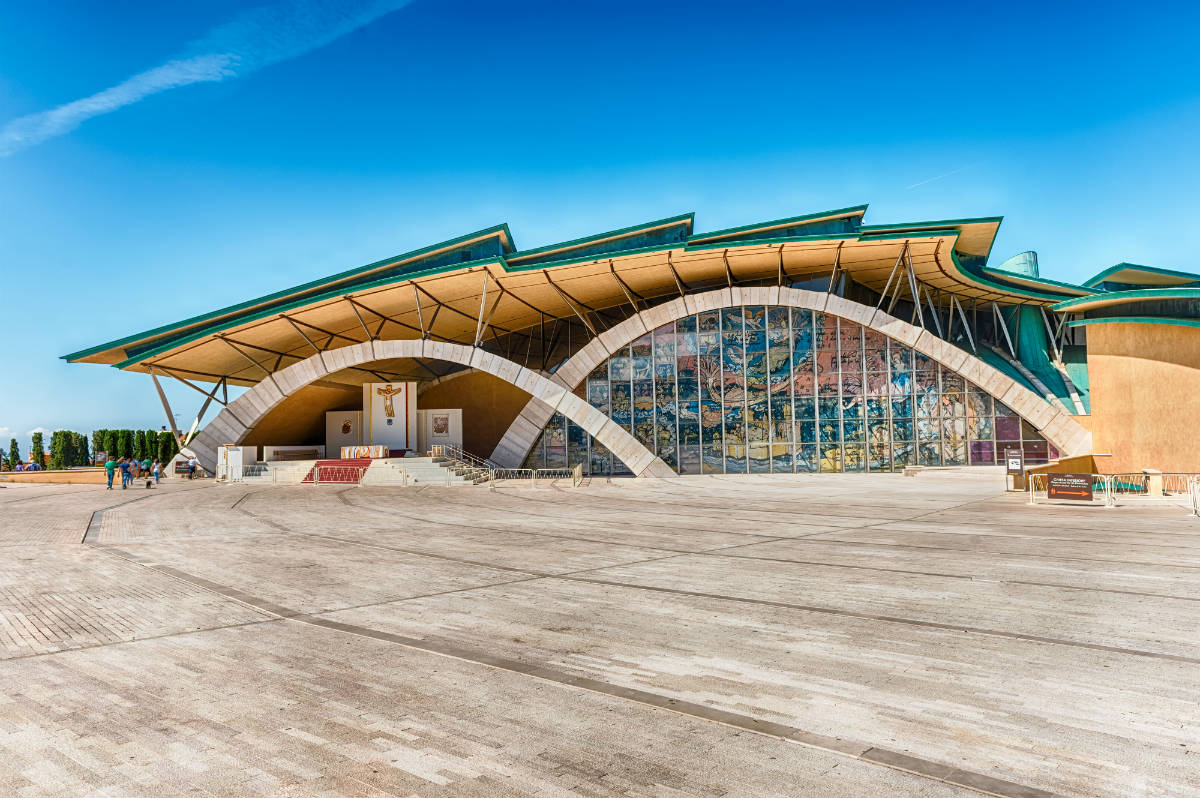The Gargano area is a wonderful land, rich in history and incredible natural landscapes. Its magic involves both tourists who have lived in this Italian region of Apulia for generations and those who visit places like Vieste or Monte Sant'Angelo for the first time. When you arrive in the Gargano, you feel its magical effects: from the clearest sea to the air purified by the scents of centuries-old olive trees and all those breathtaking views between the sky and crystal clear waters where time seems to have stood still since time immemorial. But it is not only the sea that makes Gargano great: its mountains offer uniquely evocative spectacles with ancient forests and it is rich in legends jealously guarded in the hearts of the locals.
The history of the Gargano
The Gargano is located in the northeast of Puglia, also nicknamed the "spur of Italy". From the top of its mountains, it offers a unique spectacle where sea and mountains merge, providing a unique and unforgettable atmosphere. The history of the area is very ancient and has its roots in the prehistoric age. Its origin is linked to geological facts that have made this mountainous area a unique place.
It is therefore a place rich in history and myths that testify to the bond that exists between man and nature. According to some scholars, the Gargano dates back to the Ice Age, when lower temperatures and deep sea water met land to form the mountain range. Later, Janus is believed to have lived on the slopes of Monte Sacro (the highest mountain in the Gargano) and this is where the pagan worship of nature and the gods of Greek mythology originated.
In Roman times, the Gargano was known as "the Promontory of the Daunians," a province belonging to the Roman Empire. Even today, there are Etruscan, Roman and even Byzantine buildings and monuments on these lands that testify to the ancient presence of peoples in this land. In the medieval age, the Gargano became an important place for pilgrims traveling to Rome. In particular, Monte Sant'Angelo became an important place of worship for both Christians and Muslims. According to tradition, in fact, the angel Gabriel appeared to St. Michael the Archangel on the very summit of Monte Sant'Angelo and showed him the sacred cave where he kept the Ark of the Covenant with God.
During this period of great religious devotion, the cave became a pilgrimage destination for faithful from all over Europe. Among the most distinguished visitors was St. Francis of Assisi, who visited Monte Sant'Angelo in 1218 after a long journey on foot from the city of Assisi. Traces of this visit remain today in the fresco depicting Christ Pantocrator in the church of St. Francis in Assisi.
In the Renaissance, the Gargano totally changed its appearance as a result of a number of territorial changes that led to the creation of numerous landed estates and the construction of castles and noble residences. During this period, the area was also affected by grandiose interventions such as the construction of the Manfredonia harbor, commissioned by Alfonso of Aragon in 1464.
During the Napoleonic period Bonaparte tried to rationalize the Apulian lands, but despite this, the Gargano preserved its naturalistic aspects, making it still an evocative and fascinating place today. The Gargano has always been considered a magical and enchanted place full of stories and anecdotes.
In its valleys, between sea and mountains, live welcoming people who have kept the ancient spirit of the area intact and who are proudly attached to the traditions of the past. For all these reasons, it has become a place of great tourist interest thanks to the beauty of the landscape and the welcoming and hospitable character of the locals.
A land of contrasts and beauty
The Gargano is a land of contrasts and beauty, where natural beauty blends with art and culture. It consists mainly of sedimentary rocks, limestone and dolomite, dating back to the Cretaceous and Jurassic periods, mostly stratified and affected by the phenomenon of karst dissolution.
The Gargano is a place of outstanding natural beauty, with many mountain ranges forming an incredible landscape setting. Included here is the Gargano National Park, established in 1991; it is one of the largest protected areas in Italy and is home to more than 2,000 species of wildlife, including the well-known Italic roe deer, deer, wild boar, hares, etc.
The park holds in little extent a vast biodiversity spanning the different habitats that make up the nature of the Mediterranean. These features outline a considerable diversity of fauna. This area is home to many species of migratory birds that winter here during the winter, including vultures, raptors and waterfowl of prey.
In addition to natural wonders, the Gargano also offers many architectural and cultural attractions. From the remains of ancient Roman cities such as Lucera and Siponto to splendid medieval buildings such as the Castle of Monte Sant'Angelo; from coastal towers to the imposing Sanctuary "The Church of St. Pio of Pietrelcina" in San Giovanni Rotondo; On its shores of the Gargano are also some of the most beautiful beaches in Apulia, such as those on the promontory of Vieste and the Tremiti Islands.
What to see in the Gargano
In the Gargano among the most important places to visit are the following:
- The Umbra Forest: a protected natural area that is located in the innermost part of the Gargano National Park and offers visitors the opportunity to go hiking, birdwatching and trekking among the forest's ancient trees. One can also discover the streams, waterfalls and caves found in the park.
- Vieste beach: an idyllic place where one can enjoy the unspoiled beauty of the Gargano sea. It is a beach about 8 km long with dunes, pine forests and underwater caves that make it unique. The beach is highly appreciated for its crystal clear waters and for the many water activities that can be practiced in this enchanting place.
- Monte Sant'Angelo: one of the main sacred places of the Gargano, famous for being the place where St. Michael the Archangel appeared three times to the archangel Raphael. The Sanctuary of Monte Sant'Angelo is a religious monument that attracts pilgrims from all over the world and offers an extraordinary view of the Gulf of Manfredonia and the Gargano Coast.
- Lake Lesina: is a large freshwater basin located between the Tavoliere delle Puglie and the Gargano promontory. The area around the lake is renowned for sport fishing but also for the breathtaking natural landscapes that can be admired along the lake's shore. The lake offers the opportunity to practice water sports such as water skiing, windsurfing and canoeing using various facilities on site.
- The Tremiti Islands, which offer those who visit them the opportunity to enjoy unspoiled natural beauty.
Villages to visit in the Gargano
The Gargano is one of the most spectacular territories in southern Italy. Its villages are rich in history, culture and tradition. Among them, there are some that deserve a special visit such as Vieste, one of the most beautiful villages in Italy and a must-see in the Gargano. Located on the Adriatic coast, it offers breathtaking views of the sea and surrounding mountains. Here you can find numerous tourist attractions such as the Pizzomunno beach, the Aragonese Swabian Castle, the Cathedral of Santa Maria Assunta and the sea caves. Another fascinating village to visit in the Gargano is San Giovanni Rotondo, known worldwide for being the residence of Padre Pio. Here you can visit the Sanctuary dedicated to St. Pio of Pietrelcina, the Diocesan Museum and the Shrine of Santa Maria delle Grazie.
Then we find Ischitella a small village located in the northern part of the Gargano. It offers an enchanting view of the sea and the Tremiti Islands. Here you can also admire ancient religious buildings such as the former convent of St. Francis of Assisi, the Church of Santa Maria Maggiore and the Church of Santa Maria Madre della Speranza.
Mattinata is one of the most interesting places in the Gargano thanks in part to the crystal-clear waters of the sea that particularly fascinate tourists. This seaside resort boasts one of the most beautiful beaches in the Gargano: kilometers of pebbles smoothed by a crystal-clear sea from which to leave by boat to visit the many caves, coves and small beaches accessible only by sea. The Faraglioni of Baia delle Zagare, the beach of Vignanotica and that of Mattinatella are wonders of nature.
Cagnano Varano, a small town that with its historic center characterized by stone houses, narrow streets and ancient noble palaces is an ideal place to spend a day of relaxation and culture.
Another enchanting village located in the Gargano hinterland is Peschici, whose historic center is among the most picturesque in Puglia. In addition to its wonderful beaches, worth visiting in the village is the Norman Castle dating back to the 11th century. Among the most important attractions of Peschici one cannot fail to mention its towers, built to counter the various and countless Saracen raids. Among them it is possible to visit the tower of Monte Pucci, from which you can enjoy a wonderful panorama.
Rodi Garganico is a small town perched on a promontory overlooking the sea, surrounded by lush Mediterranean vegetation. The village is rich in historical monuments, such as the Mother Church dedicated to St. Nicholas, dating back to the 13th century.
Finally, Vico del Gargano is another village of great interest to visit in the Gargano. Nicknamed the "country of love," this pretty village is one of the municipalities among the Most Beautiful Villages in Italy. Visit the recently restored Norman-Swabian Castle, the Chiesa Matrice "Chapel of St. Valentine", the Palazzo della Bella and much more.
The Gargano villages are rich in history, culture and tradition. Visiting them, you have the opportunity to discover hidden corners of paradise and spend unforgettable moments of peace and tranquility.
Eating on the Gargano: an experience not to be missed
The Gargano is a land rich in history and traditions, but also a place where cuisine expresses all its creativity. Gargano cuisine is deeply influenced by the enormous diversity of landscapes this land offers: from the crystal clear sea of the coast to the cool forests of the hinterland, the delicacies of this area are unique. From marine flavors to mountain specialties, Gargano cuisine is a meeting point of traditional and innovative flavors. Traditional dishes have retained their charm thanks to their ancient preparation and the use of fresh ingredients that is recommended by Gargano chefs.
Zuppa di pesce alla Rodiana is one of the tastiest dishes in the Gargano food and wine tradition. A dish of stewed fish, shellfish and mollusks seasoned with extra virgin olive oil, white wine, cherry tomatoes and parsley.
In Gargano, zucchini flower is one of the products that appears in several dishes, such as "Tiella di campagna", where in addition to the flower, bread is an essential element. It is a poor dish, but rich in nutrition and flavor and is composed of homemade bread, zucchini, zucchini flowers, potatoes, celery, wild fennel, cabbage, garlic, tomatoes and, of course, Gargano extra virgin olive oil.
Among the typical Gargano sweets, Pettole are a local specialty made from flour, yeast, water and oil. Once baked, they are served hot, sprinkled with sugar or honey. A real treat for the palate.
The typical products of the Gargano area really appeal to all lovers of good food and good gastronomy, and some are really special. Beyond desserts, Gargano cuisine is very rich and flavorful and includes various raw materials that are truly unique in goodness and flavor, such as, for example, caciocavallo silano, caciocavallo podolico and garganico, taralli, limoncello femminello del Gargano IGP, Arancia del Gargano IGP, Gargano thyme and rosemary, and much more.
Among these, caciocavallo podolico is a cheese with an intense and distinctive flavor, made with raw milk from podolica cows.
Gargano citrus fruits are world famous for their fragrance and goodness. These include Gargano's Duretta Oranges and Limone Femminello, the oldest lemon in Italy that is characterized by its high percentage of juice and thin, tender peel.
Another specialty of Gargano cuisine is the Lesina Eel: a prized fish that is served both fried and stewed. Among legumes, the Carpino bean is another traditional product nationally renowned for its qualities and organoleptic characteristics.
A culinary tour in the land of Gargano is therefore an experience not to be missed. Let yourself be carried away by the wonderful flavors and unmistakable aromas of this magical land, and you will not regret it!
Events in the Gargano
In the magical Gargano area, there are a world of events that draw tourists from all over the world to participate in these exceptional occasions. You can explore the land in a new light and discover the stories and secrets of its history. Events here are not only concentrated in the summer time, but dominate the whole year.
In Vico del Gargano, for example, on February 14, on the occasion of Valentine's Day the village becomes the most beloved place for lovers as it is transformed into a riot of colors given by the citrus fruits that invade the village making it unique. A tradition that has been repeated for almost 400 years now. An iconic moment during this day is when couples in love exchange a gesture of love in the charming 'Vicolo del Bacio,' an alley only 50 cm wide and 30 meters long, where for centuries lovers have exchanged romantic letters and promises of eternal love.
As for Easter events, one cannot fail to mention Holy Week, also in Vico del Gargano; Good Friday in San Marco in Lamis in which the rite of the 'Fracchie' takes place; Holy Week in Monte Sant'Angelo, experienced with events of great intensity and ancient rites; and much more.
From the Easter events we come to the summer events, among the most loved by travelers and especially by music lovers.
Prominent among these is the Carpino Folk Festival, a successful musical event that takes its cue from the historicity of the figure of the Carpino Cantors, who have carried on with great determination a musical tradition, which has been handed down from generation to generation.
Among the food and wine events, it is impossible not to mention the Festival of Fish and Typical Products, which enlivens the historic center of the village of Cagnano Varano every year in August. This is a long-awaited event for both locals and, above all, tourists.
To get to know the authenticity of this wonderful territory that is the Gargano, these events, dedicated to local culture, are always unique opportunities to discover the Spur of Italy. In short, if you decide to visit the land of the Gargano, do not forget to participate in the events that take place throughout the year.
Events in the Gargano
Villages in the Gargano
Cagnano Varano, in the Gargano National Park, is known for the famous Grotta ...
Carpino, known for the production of oil and broad beans, is considered one o...
The lake village of Lesina is an important tourist center in the north of Apu...
Monte Sant'Angelo, home to the Gargano National Park, is considered the sacre...
Peschici, an evocative fishing village which is part of the Gargano National ...
Rodi Garganico, called the "Garden of the Gargano", is characterized by its e...
Immersed in the greenery of the Gargano National Park, San Giovanni Rotondo i...
Vico del Gargano is called the country of love and its historic center is amo...
Vieste, "the Gargano Pearl", is the eastern hamlet of the namesake promontory...

















